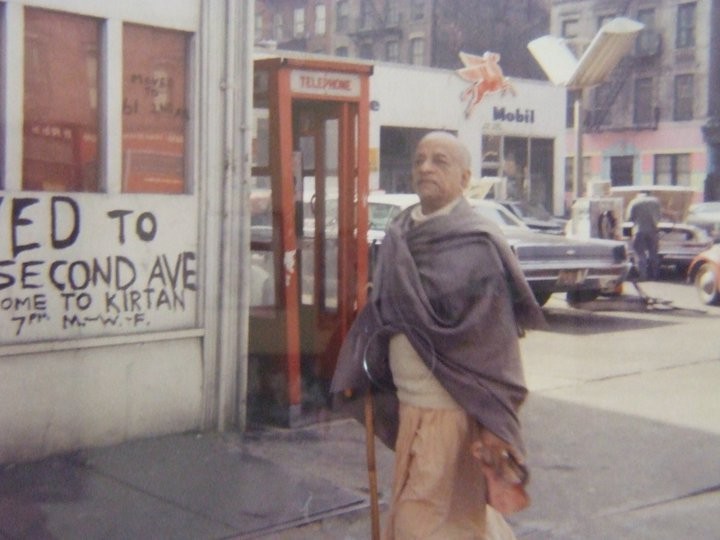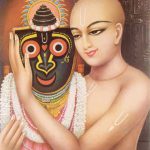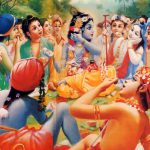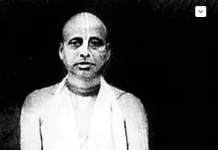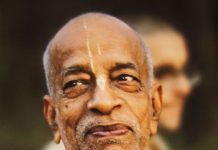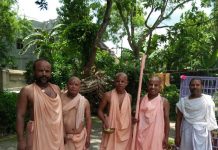by Hayagriva Dasa
I first see him just after crossing the Bowery at Houston Street. As he passes before the iron-mesh fence
of a playground, I distinctly glimpse the aura of saintliness. I watch him through the rushing traffic and
stumbling derelicts.
He strolls almost jauntily down the sidewalk. He is an old man whom age has never touched. Aloof
from the people and bustle about him, he walks proudly, independently, his hand in a cloth beadbag. He
wears the saffron robes of a sannyasi, and on his feet are quaint, pointed white shoes.
Only seven months ago, I had seen many saffron-robed monks and holymen walking the dirt roads of
Hardwar and Rishikesh, and stopping beside the Ganges to bathe. For me, that had been a futile journey
to the mystic East in search of the all-knowing guru.
But now—what’s this?
I look again at the pointed white shoes. Did this man follow me all the way from North India? Or did
he just suddenly descend from the clouds onto Manhattan sidewalks? I decide I must speak to him.
As I start across the steet, trucks rumbling toward Holland Tunnel block him from my view. I look
again to make sure that he’s still there. Yes, he even appears to be aware of me. He has all the bearing
of a great actor in a famous movie. I can’t think of what to say, but I approach him anyway.
We both stop at once. His sudden smile is moonlight in the gray July smog.
“Are you from India?” I ask stupidly.
“Oh yes,” he says, his eyes bright and expressive. Crosstown buses roar past, billowing exhaust like
clouds of incense. I sense that his tranquility is fixed in something far beyond the traffic roar. “And
you?” he asks.
“I’m American,” I say, “but I just got back from Calcutta.”
“Accha! Calcutta!” Another smile. “I am coming from Calcutta. And you were liking India?”
“Yes, well, it’s… very different.”
“And Vrindaban? You have been to Vrindaban?”
“No,” I say. “Where’s that?”
“Near Mathura,” he says.
“I’m afraid not,” I say, not knowing either place. “I got sick and had to leave.”
A poor excuse, but I can think of nothing else. His large brown eyes sparkle. How old is he? His head is
shaved, save for a few white hairs in back, and his complexion, golden Bengali, seems radiant against
saffron robes. His presence evokes quiet ashrams nestled near the Himalayas, cows, bells, temples, and
holy rivers.
“But I like India,” I add. “I’m interested in Hindu philosophy. Someday I’ll go back.”
“You are living near here?” he asks.
“Two blocks down.” I point across Bowery. “Over on Mott Street.”
“Then we are neighbors,” he says. “I want to give some classes on Bhagavad-gita. I have this one
place. I wonder if it is suitable. Maybe you can come and see?”
“Of course,” I say, and we turn and walk the half block to Second Avenue.
We stop before a small storefront between First and Second Streets, next door to a Mobil filling station,
and across the street from the Red Star Bar and Gonzalez Funeral Home. Occupying half the ground
floor of a four-story apartment building, the storefront had evidently served as a curio shop, for the
words “Matchless Gifts” were painted over the front door.
Matchless Gifts.
I notice an announcement in the window: “Lectures on Bhagavad-gita. Monday, Wednesday, Friday
7-9 p.m. A.C. Bhaktivedanta Swami.”
So, he’s a swami!
“This is a good area?” he asks.
“Oh yes,” I say. “It surely is.” Suddenly I feel sorry for the grandfatherly gentleman so far from home,
so helpless in such an alien metropolis. “I would like to hear your lectures,” I say.
“Then you must come,” he says. Another moonlight smile.
“I have friends, too,” I add, “who might be interested.”
“Yes. Very good. You must bring them.”
“I will,” I promise. “Monday evening.”
When I return to my dark, cockroach-ridden apartment on Mott Street, I tell everyone about the new
swami. We are all in our twenties—Keith, Wally, George, Wayne, Patricia, Harvey, and I. Keith and
Wally are the most interested. Keith Ham, a friend from undergraduate days, is working at Columbia
University on his doctorate in American religious history. Wally Sheffey, a recording engineer from
Chicago, is a student of Buddhism. In the course of a Mott Street evening, a conversation might revolve
around ego-loss, death, Buddha, peyote, LSD, St. John, reincarnation, Bach, astral travel, Plato, and
Lao Tzu. So the arrival of a new swami sparks immediate interest.
“Where’s he from?”
“Calcutta.”
“Maybe he followed us back,” Keith suggests.
“To a Second Avenue storefront?”
“Just two blocks away. He wonders if it’s a good neighborhood.”
“The Bowery?!”
“What’s he teaching?”
“Bhagavad-gita.”
“Now that should be interesting. Is he a guru, or avatar, or what?”
“Swami, guru—who knows?”
“Well, let’s go Monday and find out.”
“Just what we need,” Wally says. “Another guru.”
“Maybe he was sending out all those strange vibes in India,” Keith says.
“Maybe,” I say. “Anyway, let’s try him.”
I have read that meeting a guru is not an ordinary occurrence and never accidental. Life’s paths lead to
that junction only after many births. Thrown by our karma into a world war, my generation went off to
kindergarten as the Bomb fell on Hiroshima and inaugurated the atomic age. After the war, nothing
seemed impossible for Americans, and most of us began college in the fifties with great material
expectations.
Complacent as they were, the fifties were not without rebellion. When I entered the University of North
Carolina in 1958, there were beatniks on campus—only a handful to be sure, but they were noticed.
Free from parents, we delighted in adolescent rebellion, encouraged by some professors who
considered the God of Christianity dead. When one professor asked all atheists to raise their hands,
mine went up with many others. My favorite courses dealt with philosophy in literature, and my
childhood heroes, the American transcendentalists and the Catholic saints, were superseded by Albert
Camus and Jean-Paul Sartre.
As the sixties began, and my friends and I were entering our twenties, many of us gravitated to
Manhattan, where, the media informed us, everything exciting was happening. But cynicism and
rebellion could not satisfy for long. The Cuban Missile Crisis and Kennedy assassination underscored
the turbulence of the day and the need for something more than nihilism and atheism to pull us through.
By 1964, as I completed graduate work in English at New York University, my interest in American
transcendentalism revived. The joyous affirmations of Emerson, Thoreau, Whitman, Dickinson, and
Crane filled a religious vacuum. Aldous Huxley drew cultural comparisons in The Perennial
Philosophy and questioned reality with his mescaline experiences in The Doors of Perception. Students
began talking of ego-death, expanded consciousness, eternity, infinity, heaven and hell, and even God.
Camus and Sartre were discarded as dead-enders. After all, maybe the mystics, poets, saints and
dreamers were on the right track. American involvement in Vietnam increased, and with it our
restlessness and need for spiritual answers.
My friends, graduate students mostly, were undergoing some intense value changes. The world seemed
to volatile for us to follow in the footsteps of our parents by dedicating ourselves to lifetime careers, or
investing in families and expensive homes. Wanting to get at the meaning of things, we began
searching, reading mystic poets and investigating scriptures. We studied the Buddhist Sutras, Plato,
Zen, St. Augustine, the Hindus. We were on the trail of something, but what? Whenever we tried to
explain it, we would have to resort to hackneyed definitions. Something earth-shattering was
happening, surely. Was this the Aquarian Age emerging? Or did every generation experience the same
thing in a different way?
“Nothing becomes God as much as stillness,” Keith wrote on the Mott Street wall, quoting Meister
Eckhardt.
“That which you see before you is the one mind,” Wally reminded everyone, quoting Huang Po.
“If the sun and moon should doubt, they’d immediately go out,” I said, quoting Blake.
Clearly, what we needed was a guru.
With some reservations, I began teaching English in the fall of 1964 at Ohio State University.
Coincidentally, I shared an office with Mohan Lal Sharma from the Punjab. He lent me translations of
Bhagavad-gita and Shankara’s Vivekachudamani, telling me, “You must visit India. It is the cradle of
all religion and transcendentalism. There you will find your answers.” Inspired by the books, I decided
to go.
I completed the year’s contract just to earn money for passage. Keith, on leave from Columbia
University, also had a little money saved. In October, 1965, we left Newport News on the S.S.
Jaladhuta, an Indian freighter bound for Bombay, a month’s voyage. When we landed and took our first
look at Bombay, Eastern philosophy began to make sense: all life is suffering and must be transcended.
But how?
We journeyed north by train and bus to the Himalayas, to Hardwar and Rishikesh, searching for
holymen who knew enough English to give us the Word.
Unforgettable images! The clear-running Ganges, flowing aqua-green from the mountains; the monks
chanting at the dharmshala where we stayed for two weeks; the sannyasi dying along the roadside, his
saffron cloth pulled over his face, his limbs but leprous stubs, a swarm of flies buzzing about him as he
chanted in a thin, frail voice; the quiet hills and ancient temples of Rishikesh; the old rickshaw man,
straining to cycle us up a hill and cheerfully accepting his rupee tip.
But Keith and I couldn’t find any holymen who were both impressive and versed in English. Those who
knew English seemed more immersed in temple administration than philosophy or meditation, and the
itinerant sadhus with flowing beards seemed remote and uncommunicative.
We returned to Delhi, then went to Calcutta, spent a month in Bengal, and, disappointed, finally took
another freighter back to New York.
And a psychedelic New York welcomed us back. LSD had hit the street and excited the media;
everybody, it seemed, was dropping acid, taking trips, astral travelling, and reading The Tibetan Book
of the Dead. LSD cults were springing up in the Village and Lower East Side. Dropout students and
professors were travelling to ancient sun cultures and living with natives, Shivaites and Huichols,
taking hallucinogens, consulting roadmen, shamans, yogis and gurus.
And now, A.C. Bhaktivedanta Swami suddenly appears in our backyard, as if the whole chaotic stage
had been deliberately, specifically set for him.
In the display window of the Matchless Gifts storefront is a painting of five men with long hair, all
dancing with their arms raised, as if about to levitate. They are dancing in a temple—in India, the
architecture tells us—and the haloes about their heads suggest that they are saints or avatars. Their
round, lotus-eyed, cherubic faces seem frozen in celestial bliss.
“This is it,” I tell Keith and Wally, and we enter.
The storefront itself is only a fifteen by forty foot unfurnished room. Someone had placed straw mats
on the floor for sitting. At the far end are two windows, a closed bathroom door, and a badly chipped
sink. A bare lightbulb hangs from a cord in the middle of the room, another at the entrance. They are
the only lights.
We sit on the floor and look around. A half dozen other people are also sitting and waiting. Someone
with a beard and long hair introduces himself as Roy.
“The Swami’s out back and will be down soon,” he informs us.
“Out back” refers to the rear apartment building where the Swami has a second floor apartment.
As we wait, others come in. Then, through the back windows, I can see the Swami crossing the
courtyard to the storefront. He enters through the hall door and quickly slides off his white pointed
shoes. Then he sits on one of the straw mats and faces his new congregation.
His attire is humble, ascetic: a saffron dhoti worn in the style of a sannyasi monk, and a saffron chadar
over his shoulders. As he sits erect and cross-legged, his body seems to dwindle. His magnetism and
personality are concentrated in his face, large and noble like a Buddha’s. It is a serene, meditative,
grave face, a tranquil face, encompassing joy, compassion, sorrow, and much more. it is a face unlike
any other I have ever seen.
He turns to me and smiles. “You have brought your friends?”
“Yes,” I say.
“Very good.”
Picking up a pair of kartals, the kind of bell-metal hand cymbals used in temples in India, he taps them
together rhythmically—ching ching ching, ching ching ching—then begins to chant:
vande ‘ham
sri-yuta-pada-kamalam
sri-gurun
vaishnavams cha
He sings in a pure, rich baritone, a voice filled with devotion. Since no one knows what he is chanting,
no one can join in. Only after chanting for some minutes does he begin to explain the Sanskrit words.
“Hare Krishna, Hare Krishna, Krishna Krishna, Hare Hare, Hare Rama, Hare Rama, Rama Rama, Hare
Hare. Hare, Krishna, and Rama. These names of God are the transcendental seeds of the maha-
mantra,” he tells us, as Roy hands out pieces of paper with the words typed on them. “Krishna is the
name meaning ‘all attractive.’ God is not a void. God is a person, eternally youthful and fresh. He
appears just like a young cowherd boy, and His color is dark blue like a thundercloud. And Rama
means the Lord as supreme enjoyer. He is the enjoyer, Purusha, and we are the enjoyed, Prakriti. And
Hare means the energy of the Lord. Through the transcendental energy of the Lord, we can reach the
Lord Himself. So when we chant Hare Krishna, we ae saying, ‘O Lord! O energy of the Lord! Just lift
me up and place me as an atom of dust at Your lotus feet!’”
He then urges us to chant Hare Krishna in response. Slowly, awkwardly at first, we try to follow the
words on the sheets of paper. Roy and another young man join with cymbals. There are no other
instruments. There is only the hypnotic ching ching ching of the cymbals and the words of the mantra.
Eventually, we start clapping. I become aware of Puerto Ricans and derelicts clustered around the front
door and staring through the window. Strange sights on Second Avenue.
The Swami ends the chanting with three resounding chings. No one seems to know what to do next. We
all sit anticipating.
“Oh, look at all the prophets,” someone outside says.
“Look! A Buddha!”
Roy walks over to close the door.
“No, leave it open,” the Swami says. He looks at the people outside as if to invite them all in.
“Tonight,” he begins, “we will speak of the Absolute Truth.”
“The Absolute Truth,” he says, “is known in various ways by different types of yogis. The impersonalist
knows it as Brahman, the all-pervasive effulgence. The mystic followers of the astanga-yoga system
know it as Paramatma, the localized aspect of the Supreme Lord situated in the heart. But the devotees
know the Absolute Truth as Krishna, the Supreme Personality of Godhead. And in Bhagavad-gita,
Krishna declares Himself to be the Absolute Truth, Bhagavan, the possessor of all opulences.”
Somehow, when I had previously read Bhagavad-gita, Krishna seemed to me a literary personification
of the divine, a kind of folk hero incarnation, a symbol to help us understand the Self spoken of by
Shankara.
“Atma, the Self, is subordinate to Paramatma, the Supersoul,” the Swami says. “And this Paramatma is
Krishna, manifested in the hearts of all. Everything is subordinate to the personality Krishna. The
demigods, Brahman, time, space, the spiritual and material universes, and all incarnations and avataras
—all are subordinate to Krishna. Krishna is the sum total of everything; and yet He is beyond
everything. He can renounce everything and still be complete in Himself. To realize the supreme
ultimate truth is to realize Krishna, and realizing Krishna means becoming His devotee. So, every
living entity is an eternal servant of Krishna. This is our svarupa, our eternal identity.”
Our eternal identity?! Servants of a blue cowherd boy?
As the Swami talks of Krishna, I recall seeing in India popular religious paintings depicting the blue-
complexioned Lord in various pastimes: Krishna as a naughty child, turning over pots of butter;
Krishna as a playful cowherd boy sporting with His friends; Krishna as a romantic youth, playing His
flute and dancing; Krishna as a gallant warrior, driving the chariot of Arjuna in battle; Krishna as the
God of gods, revealing His universal form, which arises like a thousand suns.
“First you must hear about Krishna from the lips of a pure devotee,” the Swami says. “Shravanam. In
my childhood, in school, I first heard about America in my geography and history classes. By hearing, I
understood, ‘Oh, that is a very wonderful country, and it is very far away. If I go there, I will see big
buildings and many motorcars.’ So I had some mental conception by hearing. Or, you may not have
gone to India, but you have some idea of what it’s like by reading or hearing. You don’t go there without
knowing something first. Similarly, if we want to see God, or go to the Kingdom of God, we first must
hear. That is the process of sravanam. And kirtanam. Kirtan. You must repeat what you hear: Hare
Krishna. This kirtan, or chanting of Hare Krishna, cleanses the dust from the mirror of the mind, dust
accumulated by crores and crores of births.”
A crore, I learn, is ten million.
As the Swami lectures, my hearing slowly adapts to his accent.
“People are driven made by the illusory material energy,” he says. “For sense gratification, we undergo
crores and crores of births and deaths trying to enjoy ourselves independent of Krishna. But when our
enjoyment is directed to Krishna, we are rightly situated. This is what is meant by turning from illusion
to reality. The guru, the bona fide spiritual master, awakens this dormant, eternal relationship, and
when it is revived, we can see, hear, and speak to Krishna.
“Therefore Lord Krishna tells us, ‘Engage your mind in thinking of Me, offer obeisances and worship
Me. Thus absorbed completely in Me, you will come to Me.’”
Interrupting the lecture, an old white-bearded Bowery bum enters and walks down the middle of the
room. We sit in confused silence. He approaches the Swami.
What to do? The old beggar is wearing a raincoat and batterd hat. In his hands are paper handtowels
and two rolls of toilet paper. Without speaking, he walks past hte Swami and carefully places the
handtowels by the sink and the toilet paper on the floor beneath. Then, clearing his throat and muttering
something, he turns and walks out.
“Just see,” the Swami says with satisfaction. “He may not be in order, but he has just begun his
devotional service. Just see how naturally it comes. That is the process. Whatever we have—it doesn’t
matter what—we must offer it to Krishna.”
The lecture continues past the forty-minute mark. Some people leave, evidently baffled by the strange
philosophy, or the Swami’s Bengali accent. Undaunted, the Swami carefully and repeatedly explains
that we are not these bodies but eternal spirit souls.
“Under the influence of maya, illusion,” he says, “we are thinking, ‘I am this body, I am American, I am
a father, son, husband, wife.’ No. What am I? Spirit soul, part and parcel of Krishna. And my duty? The
part renders service to the whole: Krishna. This is bhakti-yoga. Bhakti is defined by Narada as freedom
from false bodily designations. The body, through its senses, perceives dualities such as pleasure and
pain, but these arise from the body alone. It’s just like a skin itch. The cure? Sense control through
Krishna consciousness.
“And who is Krishna? The word Krishna means the all-attractive reservoir of pleasure. We are all
hankering after some pleasure in this material world, but this material pleasure is a perverted reflection.
It is temporary. Real pleasure is there in the spiritual sky, in relation to Krishna, and it is eternal.”
Like a master weaver at the loom, the Swami weaves his discourse around Krishna. Krishna, “the
Supreme Absolute Truth,” “the Supreme Personality of Godhead,” is his main theme.
“Krishna has His name, His associates, His pastimes, His transcendental body, and His abode. He’s not
something void or impersonal. No. He’s a person.”
For us, this is the biggest news of all.
chintamani-prakara-sadmasu kalpa-vriksha
lakshavriteshu surabhir abhipalayantam
lakshmi-sahasra-sata-sambhrama-sevyamanam
govindam adi-purusham tam aham bhajami
“I worship Govinda, Krishna, the primeval Lord, the first progenitor, who is tending the
cows, fulfilling all desires, in abodes built with spiritual gem, surrounded by millions and
millions of desire trees, always served with great reverence and affection by hundreds and
thousands of Lakshmis, goddesses of fortune.”
The Swami chants this verse with such devotion that his voice evokes the image of an ever-youthful
cowherd boy whose transcendental body is sat-chit-ananda, full of eternity, knowledge, and bliss. A far
cry from the vengeful, white-beared Jehovah.
“God’s not an old man,” the Swami says. “Why should He be old? He is eternal, changeless, ever fresh,
ever youthful, ever blissful, all knowing, all powerful. Although He was a grandfather on the
Battlefield of Kurukshetra, He still appeared just eighteen or twenty.”
After an hour and a half, the lecture terminates, and the Swami asks for questions. One tall, lanky boy
asks whether or not he can see Krishna with his own eyes.
“Yes, why not?” the Swami says. “But first you must qualify yourself to see. We can cleanse our senses
by first hearing and chanting. Why put so much stress on seeing God? Hearing is just as important. you
can haer by listening to Bhagavad-gita and chanting Hare Krishna. Krishna and His names are
nondifferent, so by chanting Hare Krishna, you are actually associating with Krishna. Just try to
understand….”
The Swami continues citing examples and similes to clarify his point. We are all impressed by his
erudition, his inexhaustible supply of Sanskrit verses, and his insistence on scriptural authority. He
spends a half hour answering the boy’s question, then asks if there are any more questions. There aren’t,
and he picks up the cymbals and resumes chanting Hare Krishna. We respond as before, and the
chanting continues for another half hour. I check my watch. The program began at seven, an it is now
nine forty-five. The Swami slices up an apple and passes it to us on a metal plate. After it is distributed,
he slides into his white, pointed shoes, leaves by the side door, and walks through the courtyard to his
apartment.
I notice some people dropping coins into a wicker basket left on the straw mat. I contribute fifty cents
and leave with Keith and Wally. Everybody’s excited about the new swami.
On the way out, Roy tells us that we can visit during the day in the Swami’s apartment. The next
meeting is scheduled for Wednesday night.
By six-thirty Wednesday evening, we are drawn again, as if by magnets, to the Matchless Gifts
storefront. After the Hare Krishna chanting, the Swami reads Sanskrit verses from Bhagavad-gita and
criticizes the translation by Sarvepali Radhakrishnan, the current President of India.
“It is impersonalist,” he says, “but what can we do? We have no other version.”
The mystery of Bhagavad-gita, he tells us, is that Arjuna can remain a warrior in the world and still be
the greatest yogi by following Krishna’s directions. Since we all have to follow some authority—even if
it be our own mind or senses—we should accept the supreme authority, Krishna.
“Veda means knowledge given by God,” he says. “Bhagavad-gita is Veda, and is infallible. We must
have faith in Bhagavad-gita to make progress. Some authority must be accepted, otherwise we are
wasting our time simply talking. In Bhagavad-gita, Krishna gives us confidential information about
Himself, and there is no question of doubting it. We must understnad and accept. Otherwise, how can
we ever know anything of God? He is beyond our material perception. ‘Everything is resting on Me,’
He says, ‘but I am not there.’ You may think, ‘Oh, this table is resting in Krishna; therefore Krishna
must be here.’ But Krishna says, ‘I am not there.’ Although Krishna and His energy are nondifferent, the
energy is not Krishna. There is no difference between sunshine and the sun, but if sunshine is present in
your room, you cannot say that the sun itself is there. Similarly, everything is Krishna’s energy, but still
Krishna is beyond everything as the Supreme Person. Just because we cannot see Him, we should not
foolishly conclude that He doesn’t exist. We can see His energies working. Just as planets are floating
in the sunshine, so the sun, the universe, everything, is resting on Krishna-shine, floating in Krishna’s
energy. ‘Everything is resting on Me, but don’t think that I am finished because you cannot see Me. I am
here.’
“So, this confidential knowledge of Bhagavad-gita is especially meant for Krishna’s devotees. It cannot
be understood unless we accept Krishna as the Supreme Personality of Godhead. We cannot see God by
our own endeavor, but if we qualify ourselves, God will reveal Himself. By sincerely hearing
Bhagavad-gita and chanting Hare Krishna, we can come to understand God and our relationship with
Him.”
He then explains that just as Arjuna heard Bhagavad-gita from the lips of Krishna Himself, we should
hear it from the lips of Arjuna’s representative, the bona fide spiritual master.
“This Bhagavad-gita was first heard on the Indian plain, at Kurukshetra, but this does not mean that it
was spoken only for India, or that it is Indian. No. It is for everyone. The sun first rises in the east, then
goes to the west. This is not to say that the east has a monopoly of the sun. Bhagavad-gita may have
arisen in the land of India, but it is not India’s monopoly. It is for the whole world.”
After the lecture, the Swami asks if there are any questions. Someone asks if it is true that he is forming
an “international society,” as indicated by the sign in the window.
“Yes, ” the Swami says. “Of course, at present, this is our only branch, but this Society we are forming,
the International Society for Krishna Consciousness, is meant to teach everyone love of God by this
bhakti-yoga process. The other day, someone wanted me to call it the International Society for God
Consciousness.” He smiles and shakes his head. “But I decided no,” he says. “Krishna must be there.”
After the questions, the Swami again slices up an apple and hands it to Roy for distribution. Then,
seeing that some people are questioning the Swami further, I also approach him.
“Have you ever heard of LSD?” I ask boldly.
“No,” he says.
“It’s a chemical,” I say, vaguely feeling stupid. “Some people claim that it can give religious insights or
ecstasies. Do you think that it could be helpful in spiritual life?”
He looks at me for a moment with childlike curiosity.
“You don’t need to take anything for your spiritual life,” he says. “Your spiritual life is already here.”
Yes, it certainly is here, I think, standing before the most exalted personality I have ever seen


